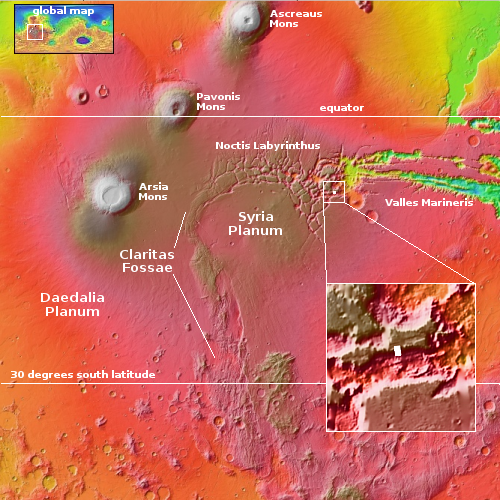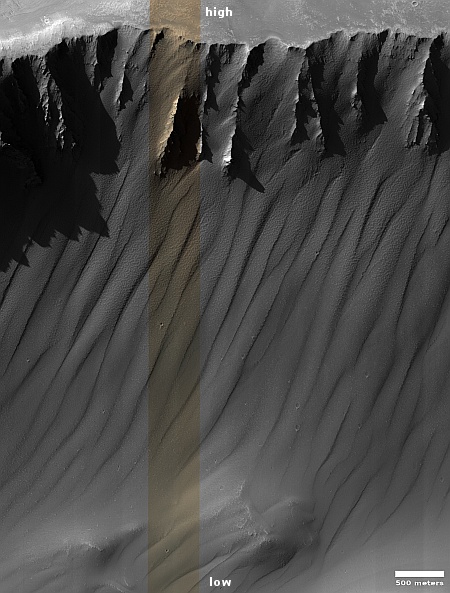Another minor canyon on Mars that would be a world wonder on Earth
Cool image time! The picture to the right, rotated, cropped, reduced, and sharpened to post here, was taken on August 6, 2023 by the high resolution camera on Mars Reconnaissance Orbiter (MRO). It shows the steep north canyon wall of one small part of the Martian canyon complex dubbed Noctis Labyrinthus
The elevation drop in this picture is about 8,000 feet, but the canyon’s lowest point is several miles further south and another 7,000 feet lower down. What is most intriguing about the geology here is its age. If you look at the full resolution image, you will see that there are scattered small craters on the smooth slopes that resemble sand that gravity and wind is shaping into those long streaks heading downhill.
Those craters, however tell us that these smooth slopes are very old, and have not changed in a long time. Furthermore, though the material appears to look like soft sand, the craters also tell us it long ago hardened into a kind of rock. If wind is shaping this material, it must be a very slow process.
The light areas on the rim as well as the ridge peaks below the rim suggest the presence of geological variety, which fits with other data that says Noctis Labyrinthus has a wide variety of minerals.

The white dot on the overview map to the right marks the location in Noctis Labyrinthus, east of Mars’ giant volcanoes and near the western beginnings of the 1,500-mile-long Valles Marineris canyon to the east.
Once again the monumental scale of Mars astonishes. This small canyon section of Noctis Labyrinthus is twenty miles wide at this point, with a depth of 15,000 feet or almost three miles. Its length is harder to determine because of the complexity of canyons here, but using the longest option it is about 250 miles long.
You could easily fit two Grand Canyons inside it, with space to spare. Yet it is merely one small canyon section in a maze of canyons almost 600 miles long and 200 miles wide.
Though the origins of Noctis Labyrinthus are as yet not completely understood, the generally accepted theory is that ground here was pushed up by volcanic activity, causing the ground to crack to form the initial canyons. Over time erosion, possibly linked to wind, water, ice, or lava, has widened those canyons.
On Christmas Eve 1968 three Americans became the first humans to visit another world. What they did to celebrate was unexpected and profound, and will be remembered throughout all human history. Genesis: the Story of Apollo 8, Robert Zimmerman's classic history of humanity's first journey to another world, tells that story, and it is now available as both an ebook and an audiobook, both with a foreword by Valerie Anders and a new introduction by Robert Zimmerman.
The print edition can be purchased at Amazon or from any other book seller. If you want an autographed copy the price is $60 for the hardback and $45 for the paperback, plus $8 shipping for each. Go here for purchasing details. The ebook is available everywhere for $5.99 (before discount) at amazon, or direct from my ebook publisher, ebookit. If you buy it from ebookit you don't support the big tech companies and the author gets a bigger cut much sooner.
The audiobook is also available at all these vendors, and is also free with a 30-day trial membership to Audible.
"Not simply about one mission, [Genesis] is also the history of America's quest for the moon... Zimmerman has done a masterful job of tying disparate events together into a solid account of one of America's greatest human triumphs."--San Antonio Express-News
Cool image time! The picture to the right, rotated, cropped, reduced, and sharpened to post here, was taken on August 6, 2023 by the high resolution camera on Mars Reconnaissance Orbiter (MRO). It shows the steep north canyon wall of one small part of the Martian canyon complex dubbed Noctis Labyrinthus
The elevation drop in this picture is about 8,000 feet, but the canyon’s lowest point is several miles further south and another 7,000 feet lower down. What is most intriguing about the geology here is its age. If you look at the full resolution image, you will see that there are scattered small craters on the smooth slopes that resemble sand that gravity and wind is shaping into those long streaks heading downhill.
Those craters, however tell us that these smooth slopes are very old, and have not changed in a long time. Furthermore, though the material appears to look like soft sand, the craters also tell us it long ago hardened into a kind of rock. If wind is shaping this material, it must be a very slow process.
The light areas on the rim as well as the ridge peaks below the rim suggest the presence of geological variety, which fits with other data that says Noctis Labyrinthus has a wide variety of minerals.

The white dot on the overview map to the right marks the location in Noctis Labyrinthus, east of Mars’ giant volcanoes and near the western beginnings of the 1,500-mile-long Valles Marineris canyon to the east.
Once again the monumental scale of Mars astonishes. This small canyon section of Noctis Labyrinthus is twenty miles wide at this point, with a depth of 15,000 feet or almost three miles. Its length is harder to determine because of the complexity of canyons here, but using the longest option it is about 250 miles long.
You could easily fit two Grand Canyons inside it, with space to spare. Yet it is merely one small canyon section in a maze of canyons almost 600 miles long and 200 miles wide.
Though the origins of Noctis Labyrinthus are as yet not completely understood, the generally accepted theory is that ground here was pushed up by volcanic activity, causing the ground to crack to form the initial canyons. Over time erosion, possibly linked to wind, water, ice, or lava, has widened those canyons.
On Christmas Eve 1968 three Americans became the first humans to visit another world. What they did to celebrate was unexpected and profound, and will be remembered throughout all human history. Genesis: the Story of Apollo 8, Robert Zimmerman's classic history of humanity's first journey to another world, tells that story, and it is now available as both an ebook and an audiobook, both with a foreword by Valerie Anders and a new introduction by Robert Zimmerman.
The print edition can be purchased at Amazon or from any other book seller. If you want an autographed copy the price is $60 for the hardback and $45 for the paperback, plus $8 shipping for each. Go here for purchasing details. The ebook is available everywhere for $5.99 (before discount) at amazon, or direct from my ebook publisher, ebookit. If you buy it from ebookit you don't support the big tech companies and the author gets a bigger cut much sooner.
The audiobook is also available at all these vendors, and is also free with a 30-day trial membership to Audible.
"Not simply about one mission, [Genesis] is also the history of America's quest for the moon... Zimmerman has done a masterful job of tying disparate events together into a solid account of one of America's greatest human triumphs."--San Antonio Express-News



The crate marks also don’t look to be very deep nor have any side walls to speak of. Is this due to hardened rock -really hard? or a glancing blow or both?
It looks to be compressed ash, thousands of feet of identical texture/marbling, there’s no sediment layers like we see in other locations. Impact Craters hardly make a dent, no obvious erosion taking place in the sidewalls which is unusual. Could have drifting ash from the volcanoes mostly fallen thousands of feet thick in this one area? Mars atmosphere is thin, so the heavier ash will not go far.
I would point out the shadows being cast by the protrusions in the upper wall… You can’t see it from our angle but a shadow that is incredibly long (like Pinocchio‘s nose). An anomaly that may only be possible in low gravity.